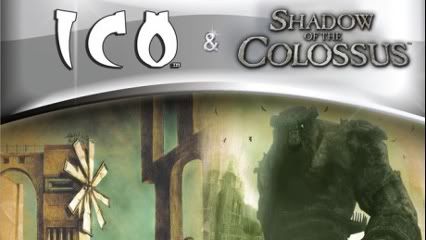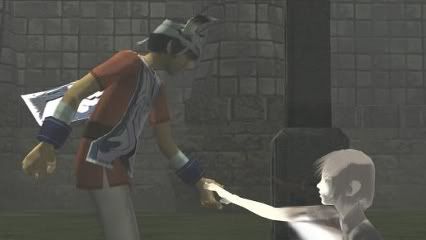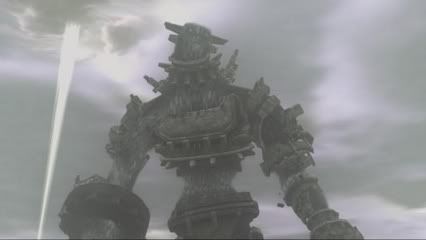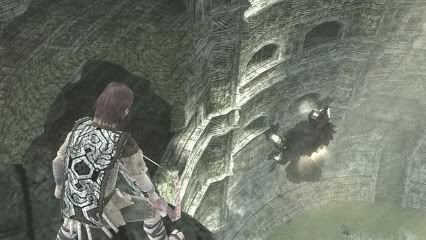
- Format: PS3
- Unleashed: Out Now
- Publisher: Sony Computer Entertainment
- Developer: Team Ico/Bluepoint Games
- Players: 1
- Site: http://uk.playstation.com/icoshadowofthecolossusclassicshd/
So well loved are these PS2 cult classics, this disc became an essential purchase for many as soon as it was announced. If you missed one or both titles the first time around, then all the more reason to buy it; let us tell you why.
Ico is a platform puzzler, but that simple description is just a weak shadow of the actual experience. There is a story, but it’s told in a carefully crafted minimalist style; even when you’ve completed the game for the first time, you know little more for sure than you and the girl you rescued were imprisoned in a castle, and you both just spent the entire game doing everything you could to escape. The fictional languages used, only partly translated in subtitles (first time around) enforce this.
Although you quickly find Yorda (the girl) who then stays by your side much of the time, the entire game is painted with melancholy and loneliness. There are places where you simply run along a lengthy path, and here the camera pulls out to show you running alone through the huge expanse, often with nothing to be heard but the empty whistling of the wind. This atmosphere, combined with the almost total lack of hand-holding, makes it a clear influence on Limbo.
 There is literal hand holding however. Though Yorda has powers that open paths for you both throughout the castle, she is otherwise completely helpless – and relies on you for help constantly. There is a dampened sense of hope as you call her to you, hold her hand as you run along to keep her by your side, pull her up to a higher platform, or reach out to her across a gap ready to help her make the jump.
There is literal hand holding however. Though Yorda has powers that open paths for you both throughout the castle, she is otherwise completely helpless – and relies on you for help constantly. There is a dampened sense of hope as you call her to you, hold her hand as you run along to keep her by your side, pull her up to a higher platform, or reach out to her across a gap ready to help her make the jump.
Some puzzles will require you to leave Yorda while you explore places she cannot reach. The longer you leave her alone, the more tense you become, particularly if you fret about taking a wrong turn – because of the ‘shadowmen’. These dark beasts appear throughout the castle, often without warning, to kidnap her. If they pull her down into a shadowy pool and you don’t pull her out quickly enough, you turn to stone and it’s game over.
Combat is overly simplistic, consisting simply of hitting enemies with whatever weapon you have via the attack button until they fall over and don’t get back up. With a stick (also used for fire based puzzles), these battles are an agonisingly slow process, and can feel like they’re just getting in the way of the rest of the game. The collision detection is frustratingly inaccurate in a few places, a hangover from the PS2 original that you’ll discover when trying to grab certain ledges from certain spots. Yorda’s AI could also have done with a little sharpening; but despite all this Ico is so unique and captivating, these faults are easy to forgive.
 In terms of atmosphere, Shadow of the Colossus has much in common with Ico. The loneliness and sadness is strong before you even take control, as you watch a lone wanderer on his horse riding slowly through a dank landscape. The bundle on his horse turns out to be the body of a recently deceased young woman, which he places upon an altar in the temple of a forbidden land. He appeals to a legion of gods known as Dormin to resurrect her; Dormin tells him this can be done if he kills the sixteen colossi in this land.
In terms of atmosphere, Shadow of the Colossus has much in common with Ico. The loneliness and sadness is strong before you even take control, as you watch a lone wanderer on his horse riding slowly through a dank landscape. The bundle on his horse turns out to be the body of a recently deceased young woman, which he places upon an altar in the temple of a forbidden land. He appeals to a legion of gods known as Dormin to resurrect her; Dormin tells him this can be done if he kills the sixteen colossi in this land.
These colossi are the only enemies in the game. There are lizards with shining tails which will increase your stamina (used to maintain grip) and fruit to find which will increase your HP bar, but nothing will attack you except the colossi. You only ever tackle one at a time, in a predetermined order.
The basic sequence for each fight is the same. Dormin gives you a vague description of the colossus’ location, and you ride out from the temple on your horse to find it. Your sword acts as a sort of pathfinder; hold it up to the sunlight, and the reflected rays will converge in the direction you need to go (this too needs sharpening at times). You’ll race across fields, jump over gaps, climb walls, shimmy across ledges, and swim through lakes on your journeys. When you’ve found the colossus you’ll often need to use the environment, which will make a sort of arena, to your advantage.
 The formula for killing a colossus runs thus: Identify the weak spots, find a way to jump onto the giant so you can clamber around on it, then reach and stab these weak points with your sword until the monster – which will do its best to shake you off – falls.
The formula for killing a colossus runs thus: Identify the weak spots, find a way to jump onto the giant so you can clamber around on it, then reach and stab these weak points with your sword until the monster – which will do its best to shake you off – falls.
The PS2 original had noticeable pop-up in the most open areas of the land, and it hasn’t been fixed here (nor have the muddy PS2 colours for the most part, it seems). The game camera also needs tightening up in places, and aiming your bow can still feel more imprecise than necessary. Nonetheless, these prove to be minor complaints.
Each colossus is a sullen, intricate work of art brought to lumbering life. Apart from the two which are disappointingly similar in appearance and attack, they are also each the size of a small mountain – and more mesmerising than ever in HD. Even if frustrated by the sequence necessary to jump onto the giant (most likely during the final encounter), climbing around on the largest of the colossi remains an incredible experience. The odds seem piled against you; yet with planning, care and thought, you succeed. This game also rewards you with one of the best endings you will ever see.
These games are expertly woven experiences not to be missed, and remind you how little most videogames explore what is possible with the medium. They would not work as movies or books. If you have a PS3, you need to buy this.



















Comments